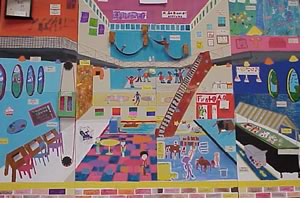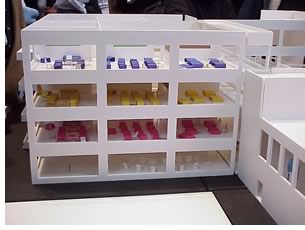

D.C. students, mentors delight in design process

by
Tracy F. Ostroff
Associate Editor
D.C. public school students pitched their energy-efficient school building plans to a professional architecture jury last week, incorporating with abandon technologically advanced designs, as well as elements of whimsy and convenience, such as a skateboard park and escalators. Guided by architecture students from Howard University and the University of Maryland, the middle schoolers designed their own ideal learning environments as a part of School Building Day, a program sponsored by the Council of Educational Facilities Planners International (CEFPI), the U.S. Department of Energy’s (DOE) Rebuild America program, the U.S. Environmental Protection Agency (EPA), and more than 40 organizations, including the AIA.
 About
50 Washington, D.C., public school students and their teachers participated
in the program, a six-week competition in which the children were tasked
with designing high-performing, healthy, safe, and energy-efficient classroom
models. The student’s efforts were part of a larger School Building
Week initiative, which aimed to focus attention on the issues of air quality
and energy use in American schools. Now in its seventh year, the program
has expanded to include school districts nationwide, with schools taking
part in a variety of awareness and education programs, including essay
competitions, examinations of alternative delivery methods for school
design, and planning programs for schools as places of lifelong learning.
This is the first year that the student mentors formally participated.
They will be honored with a breakfast hosted by AIA Executive Vice President/CEO
Norman L. Koonce, FAIA, at the AIA national component headquarters.
About
50 Washington, D.C., public school students and their teachers participated
in the program, a six-week competition in which the children were tasked
with designing high-performing, healthy, safe, and energy-efficient classroom
models. The student’s efforts were part of a larger School Building
Week initiative, which aimed to focus attention on the issues of air quality
and energy use in American schools. Now in its seventh year, the program
has expanded to include school districts nationwide, with schools taking
part in a variety of awareness and education programs, including essay
competitions, examinations of alternative delivery methods for school
design, and planning programs for schools as places of lifelong learning.
This is the first year that the student mentors formally participated.
They will be honored with a breakfast hosted by AIA Executive Vice President/CEO
Norman L. Koonce, FAIA, at the AIA national component headquarters.
National Building Museum Chief Curator Howard Decker, FAIA, and CEFPI President Thomas A. Kube helped kick off the Washington program, noting that new research is continually demonstrating the link between high-performing students and well-planned school facilities.
One of the event’s two keynote speakers, Jeffrey Holmstead, EPA’s assistant administrator for Air and Radiation, spoke about the “magic” that school facility planners and creative communities add to their schools. The average school in the U.S. is about 42 years old, Holmstead said, noting that older buildings have increased risks for poor indoor environments that lead to long-term and chronic health problems, including asthma. Holmstead announced at the event that within the next few weeks the EPA will issue new guidance on air-quality design tools for schools, especially for school restoration and renovation programs. The new publication will complement “Tools for Schools,” an online kit that helps teachers and administrators prevent indoor-air-quality (IAQ) problems and resolve such problems promptly if they do arise.
 The
DOE’s John P. Millhone, program manager, Office of Weatherization
and Intergovernment Programs, Office of Energy Efficiency and Renewable
Energy, said that school energy expenditures cost $6 billion, the second
highest expense for school districts, coming in just less than teachers’
salaries. He pointed to the work of architects to implement innovative
building programs in the D.C. public schools, such as solar technology,
daylighting, and other renewable resources to meet the everyday needs
of schools, and highlighted a DOE program that encourages students to
find ways to conserve energy in their own schools. Millhone said that
these efforts, combined, would help preserve our environment, make the
U.S. less dependent on outside energy sources, and improve our nation’s
security.
The
DOE’s John P. Millhone, program manager, Office of Weatherization
and Intergovernment Programs, Office of Energy Efficiency and Renewable
Energy, said that school energy expenditures cost $6 billion, the second
highest expense for school districts, coming in just less than teachers’
salaries. He pointed to the work of architects to implement innovative
building programs in the D.C. public schools, such as solar technology,
daylighting, and other renewable resources to meet the everyday needs
of schools, and highlighted a DOE program that encourages students to
find ways to conserve energy in their own schools. Millhone said that
these efforts, combined, would help preserve our environment, make the
U.S. less dependent on outside energy sources, and improve our nation’s
security.
Student’s design dreams
Students from the six participating middle schools proudly showed off
their “no holds barred” designs, clearly demonstrating that
they are aware of the positive impact design can have on their built environment.
Jury Chair Lee Brockway, principal emeritus of Fanning/Howey Associates,
Inc., shared some of the panel’s comments with the audience. Evans
Middle School’s plan, for example, had a “strong environmental
focus with supporting technical details,” while MacFarland Middle
School’s program provided for “exceptional daylighting”
and “vertical and horizontal connections fostering strong sense
of community academically and socially, with an atrium, student lounges
with balconies, and a media-center rotunda.”
 While
the jury applauded all the student’s efforts, they recognized two
schools—Stuart-Hobson and Hardy—for their clearly articulated
planning process and fresh thinking, which included a “thinking
center” versus a “library” and opportunities for community
participation and connections. Hardy’s “vibrancy, color, imagination,
and innovation all speak to the joy of learning and the spirit of the
students while Stuart-Hobson’s work “articulates qualities
that should be included in a good learning environment.” The students
from these two schools will be feted with a pizza party, sponsored in
part by the AIA.
While
the jury applauded all the student’s efforts, they recognized two
schools—Stuart-Hobson and Hardy—for their clearly articulated
planning process and fresh thinking, which included a “thinking
center” versus a “library” and opportunities for community
participation and connections. Hardy’s “vibrancy, color, imagination,
and innovation all speak to the joy of learning and the spirit of the
students while Stuart-Hobson’s work “articulates qualities
that should be included in a good learning environment.” The students
from these two schools will be feted with a pizza party, sponsored in
part by the AIA.
The architecture jury convened in Washington, D.C. In addition to Brockway,
the jury included Decker; Professor Amy Gardener, of the University of
Maryland and Hillier, Inc.; Judy Hoskens, senior education planner and
project manager, Cunningham Group; George Springer, administrator, Washington
Teachers Union, American Federation of Teachers; Yale Stenzler, YES Consulting,
LLC; Dan Sze, director of the DOE Rebuild America program; and Kenni Walker,
a student at the Howard University School of Architecture and Planning.
Copyright 2003 The American Institute of Architects.
All rights reserved. Home Page ![]()
![]()
